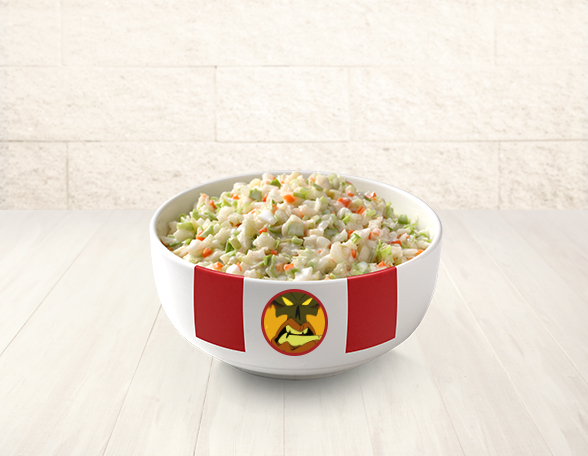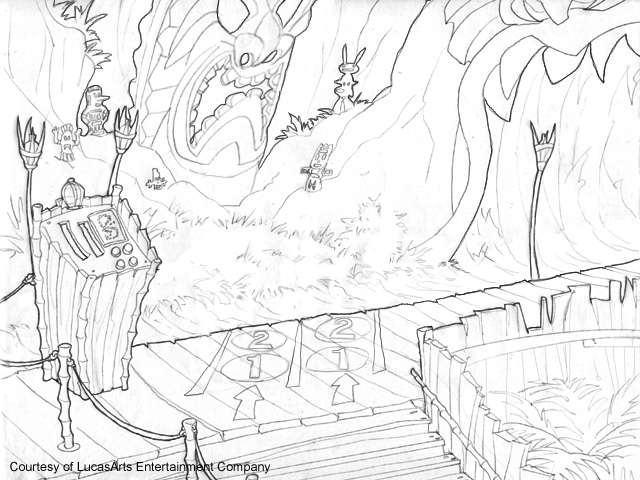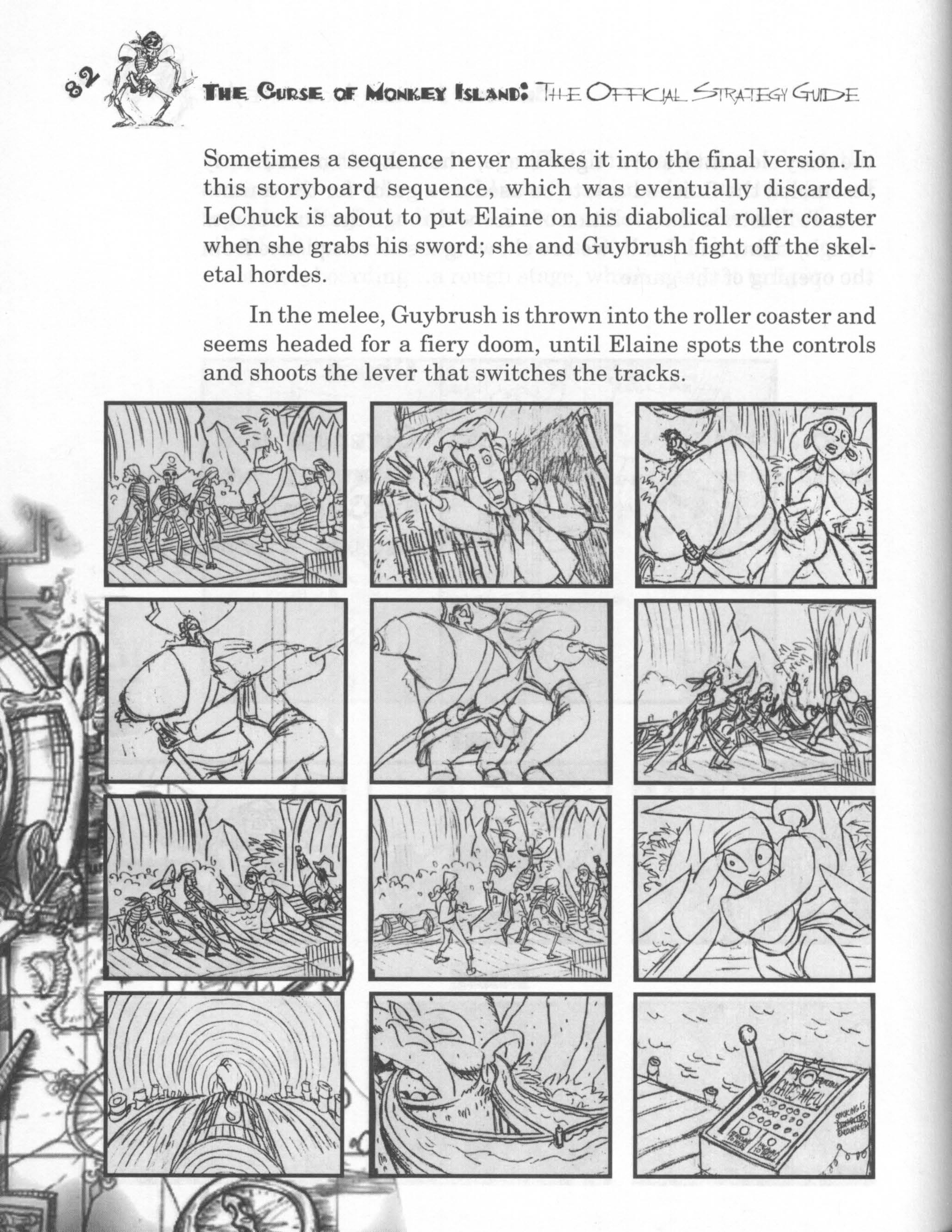Articles

Jonathan Ackley and Larry Ahern look back on 25 years of CMI Page Three
The ambiguous ending of LeChuck’s Revenge was a wild flourish in the context of that game, but represented major baggage for anyone wanting to continue the series afterward who wasn’t named Ron Gilbert. Ultimately, Curse addresses this with a gigantic dialog tree near the end of the game, most of the branches of which are optional. I’m curious if any other ideas were puttered around with for dealing with this albatross before you landed on the one you did?
Jonathan: Dealing with the Monkey 2 ending later in the game was more about making the experience accessible to new players. Imagine popping in the CD of your new Pirate game and trying to figure out why there are demon kids in a pirate carnival.
This was the first Monkey Island game to feature voice acting. Dominic Armato was a stunningly perfect Guybrush, but the voice work is just exceptional, casting and direction both, from top to bottom. Can you speak to your collaboration with voice director Darragh O’Farrell in the VO process?
Jonathan: Darragh is a pro. We discussed each character, their motivations and our thoughts for what they might sound like. Then he’d go out and come back with audition tapes from the actors.
Finding Guybrush was the most difficult. We had rejected so many. Then one day, Darragh came in and said, “I’ve got one more for you. There’s this kid and he keeps saying, ‘You don’t understand. I AM Guybrush Threepwood.”
That was Dominic Armato.
Larry: Since working at LucasArts, I’ve written and done VO sessions for lots of other projects and consistently find myself having to chime in to guide or correct a performance. It’s hard for someone who didn’t write the lines to know the writer’s intention, so that happens. Darragh had 8,000+ lines of dialog to record and we were only there for the demo VO sessions to give him general guidelines on the characters. I have no idea how he was able to read our minds and get those amazing performances (although, I’m sure it helps that Dominic IS Guybrush).
Dom has said that the “A Pirate I Was Met To Be” number represented a rare occasion where the voice actors were in the same room together. Were you able to attend that session, or any of them?
Jonathan: Darragh only invited us to the first few recording sessions. Then he sent us packing. With actors, it’s always best if there is only one director.
As with the VO it’s hard to talk about the game’s soundtrack without gushing a series of superlatives. Michael Land’s score is simply a tour de force, and the sound design (Clint Bajakian and Julian Kwasneski) is top notch too. Together with the visuals, the soundscape gives The Curse of Monkey Island one of the more fully-formed atmospheres I can think of in a computer game. It really makes you just want to hang around in that world -- Blood Island in particular reaches massive highs, and I’d stack up that whole segment against any stretch in any Monkey Island game. Considering you guys witnessed each gradient of the game’s progress over a two-year period, was there a particular moment where the elements all seemed to come together at once and make the thing come alive -- where you got to experience a similar revelation that the rest of us did?
Larry: I don’t know the first thing about music other than that the LucasArts composers were amazing and we just needed to let them do their thing. I do remember Michael inviting us to the recording session for the opening theme, though. He had booked a woman who apparently was the world’s best/one of the best marimba players (is that the right instrument? It’s that wooden xylophone-looking thing). I just listened to her play and smiled. I always knew it was going to be great, because everything they’d done on the previous games was amazing. But that was the moment when I first heard it being great.
Jonathan: I didn’t have that kind of “ah-hah” moment, because I was working with Michael to implement the programming of the interactive music, so I didn’t have distance from it. While we gave Michael some notes on the feel of each scene, music was the least of our worries, so we generally let him do his thing.
As to the musicianship and composition, it’s still my favorite soundtrack from any game.
The Curse of Monkey Island has proven to be as influential a game on the series as a whole as any of them, which is noteworthy for a sequel. When I make this claim I think of the fact that the subsequent sequels have consciously quoted the visual style to some extent (those curly clouds keep showing up), the fact that your casting decisions were almost all respected when characters were carried over in the subsequent installments (and even the prior ones, thanks to the Special Editions coming along and making the first two games talk), the fact that its iconography is often favored in series-wide promotional materials, the endurance of Murray the talking skull, etc. It got a stamp of approval from all the Monkey Island vets who’ve spoken about it, and a quick peak at the reviews on GOG and Steam show that it remains beloved, with the word “favorite” thrown around pretty readily. My question is, did you have any sense of the kind of half-life the game would have when you were making it?
Jonathan: I had hoped it would have lasting power. I thought it was the most ‘complete’ game I’d worked on, in terms of unity of design and production. But I was really worried. At the point Curse came out, LucasArts wasn’t making games for the Mac. Since the Mac architecture was much more modern, only the SCUMM games that came before were playable into the new millennium. But THEN came SCUMMVM. It’s amazing what talented, die-hard fans can achieve. It brought Curse back. I still don’t know what madperson ported the Insane libraries.
Larry: I’m just happy we didn’t break the IP. It’s so rewarding to see the elements we got excited about live on for fans in their memories and in the sequels. I suppose we must have done something right if the fans are still talking about it. Okay, so now the only thing left to do now is a remaster - when do we start (not that I have any say in making that happen)?
A much smaller but more amusing legacy: Curse introduced Guybrush’s seemingly inexplicable revulsion to porcelain, a character trait that subsequent sequels have carried over. Chris Purvis has guessed that this was meant to be in reference to Guybrush having a vase smashed over his head by Fester Shinetop in the first game, while others think it’s a total non-sequitur. Care to settle the matter?
Jonathan: Contrary to Internet theories, Guybrush isn’t afraid of porcelain based on getting hit on the head in Monkey 1. I’m really surprised there’s so much confusion around this. Isn’t it obvious? I mean c’mon. We’re talking about PORCELAIN here!
Larry: This is the second-biggest secret of Monkey Island, so I’m afraid we can’t say more.
Another Chris Purvis anecdote: He remembered that the stage light puzzle (in which Guybrush meddles with the buttons above the theater) originally took the form of an elaborate parody of The 11th Hour that you all ultimately thought better of committing to. Any recollection of this?
Larry: I have no recollection of this. Probably more of the programmer/writer day-to-day minutia that I wasn’t privy to because I was too busy in the art trenches.
Jonathan: Chuck Jordan wanted to have a floating skeleton hand for a cursor in the scene, with a spooky voiceover spouting warnings when you pressed a wrong button. The joke didn’t hit home with Larry and I, as I think we thought it was too obscure. We didn’t prevent him from adding it, though. The idea just sort of faded away.
I always associate The Curse of Monkey Island with the explosion of the online fan scene, which happened at about the same time. (Mixnmojo also turns 25 this year.) Many of the fan sites from that era were defacto Curse fan sites, and it’s hard for me to separate the game from “ground zero” of the web communities. What was it like from your side of the transom? Was there awareness of this burgeoning scene from inside the studio, and what if any kind of impact did it have?
Jonathan: Not for me. The Internet was pretty new and dial-up was super slow. We visited the SCUMM Bar and Mix-n-Mojo, but that was about it for our visibility into the Monkey Island fan base.
Larry: I was completely clueless. But the internet was a new and strange place back then. I just remember that we previously had to get in a car and go to the library to look things up if we didn’t know the answer to something. It could take hours. Then during early development on Curse we were working on the snake puzzle and figuring out all the things to put inside that Guybrush couldn’t quite reach. One of the items was the Jaws of Life. Bill came to us and said, “I don’t know what Jaws of Life looks like,” and we all realized that none of us had ever seen one. Then Jonathan, being the technical wizard that he is, said, “Maybe the internet knows!” He did a preliminary search of all 139 sites on the web and found a photo. And it only took 10 minutes. We were speechless. Also, Jaws of Life aren’t as exciting or dangerous looking as the name suggests.
Twenty-five years is a long time for fans to have uncovered all the game's secrets and picked up on the subtler in-jokes. Still I’ll ask: any Easter eggs that might have been missed?
Larry: I wouldn’t know. Easter eggs tend to be the kinds of things that bored programmers add. I probably couldn’t name more than 1 or 2. But then again, I don’t think I can remember the solutions to half our puzzles after 25 years either, so why are you even interviewing me. Jonathan…?
Jonathan: I don’t think so. I think they’ve all been found.

The game has a somewhat abrupt final act, and the game’s hint book sheds some light on how it came to be that way: we have storyboards of a scrapped cutscene as well as lyrics for a full-fledged song and dance number originally meant to run over the end credits. Can you elaborate in any detail on the material that was cut for budget reasons?

Jonathan: The Elaine fight scene was really the only scene we didn’t finish. The song was written and ready to record. It’s my fault it’s not in the game. Michael came to me to get me to sing it (I’m a karaoke fiend), and I refused, as I thought it was narcissistic to put myself in the game. I totally regret it now, because the song was great.
Larry: I regret that Jonathan didn’t record the song too, as it would have been narcissistic and given me tons of opportunity to tease him over the last 25 years. The Elaine fight scene was our original plan, but it was going to be a lot of work. In hindsight, we probably should have come up with something in between that and the more abrupt ending we delivered. But at the time we were already a little over our deadline and worried about pushing it too far. Although the money from a Billboard #1 Plank of Love might have made management more likely to forgive any delays.